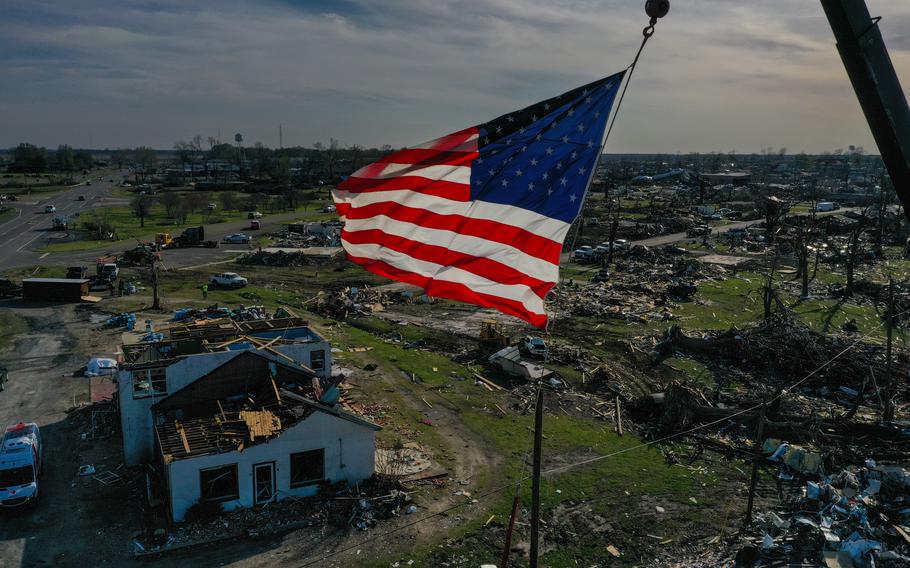
A massive tornado laid waste to much of Rolling Fork, Miss., on March 28. (Jahi Chikwendiu/The Washington Post)
Tornadoes have taken a tragic toll on life and property this year, and most of the April-to-June peak period still lies ahead. About 60 people have died in tornadoes in 2023, nearly three times higher than all of 2022, when 23 people died.
So far this year, 17 killer twisters have formed, 14 of them since late March, including a pair in Missouri and Kentucky on Wednesday.
Amid violent outbreaks of rotating storms, tornado deaths spiked on both March 24 and March 31. Twenty-three people died, including 16 in Rolling Fork, Miss, on March 24. At least 24 more people were killed as tornadoes swarmed the central states on March 31. More than 100 tornadoes spun up that day, among only a handful of days with that many on record.
At around 50 victims, the tornado death rate in March ranks as the fourth-most on record during that month since 1950. There were also nine tornado deaths in January and February.
This season’s tornado activity, which may have begun in November and December of last year when there were seven tornado fatalities, may be linked to a La Niña climate pattern.
La Niñas tend to deliver powerful dips in the jet stream throughout the winter and into spring, which increases shear, or turning of the wind with altitude, and storm rotation.
Even when La Niñas fade, as has been the case in 2023, early spring tornado activity often remains high. The Super Outbreak of April 2011 happened on the heels of a La Niña winter.
Storms have also been fueled by frequent record-breaking warmth in the South and abnormally high Gulf of Mexico sea surface temperatures, which may indicate a contribution from human-caused climate change.
Beyond the background weather pattern, luck also plays a role.
“If you have outbreaks in unpopulated areas nobody dies,” Harold Brooks, a senior research scientist at the National Severe Storms Laboratory, wrote in an email. “Most tornadoes that kill people, if you move the path a few miles it goes way up or down.”
Numerous tornadoes this year have hit highly populated zones, including the South, where there is a disproportionate number of mobile homes, which are particularly vulnerable. Brooks noted a person is “15 to 20 times more likely to be killed in a mobile home” compared to sturdier housing.
The tornado death toll this year, only about 25 percent complete, is closing in on the annual average of around 70. In 2018, the country saw a record-low 10 deaths during the first year on record with no violent tornadoes, rated EF4 or higher on the 0-to-5 scale for intensity.
As recently as 2021, tornado fatalities topped 100, with more than 80 coming in December alone, the most on record for that month. That high toll was largely because of an unusually powerful December rotating storm that tracked from Arkansas to Kentucky, dropping multiple killer tornadoes, including the disastrous Mayfield, Ky., twister.
Tornado deaths in recent years — while high at times — pale compared to numbers from the past. Brooks’s research indicates that tornadoes death rates averaged 1.8 people per million from 1875 to 1925 but are now just 0.16 per million. That’s about a 90 percent reduction. The decline in tornado death rates reflects improved tornado warnings and responses.
Historically, April is the deadliest month for tornadoes, followed by May. Tornado fatalities are usually at their lowest from July through October before a small uptick in winter.
But every year is different, Brooks stressed. A deadly start of the tornado season sometimes brings quieter subsequent months.
“In the last 70 years, about 12 have had more than half of the deaths for the year before the end of March,” Brooks said. “Just because there are a lot of fatalities in March doesn’t necessarily mean this will be really huge death toll year.”
But tornado fatalities can leap in April and May. Through the first week of April in 2011, there were only three tornado deaths. By the end of the month, it was past 350, and the Joplin disaster that claimed another 150-plus lives in May was yet to come.
Brooks said 2011 was “by far the biggest death toll in my lifetime, but an average year for my great-grandparents.”
As the United States heads deeper into peak tornado season, the next week to 10 days should feature a quieter weather pattern. After that, the raging thunderstorms of spring may return.
The Washington Post’s Jason Samenow contributed to this report.